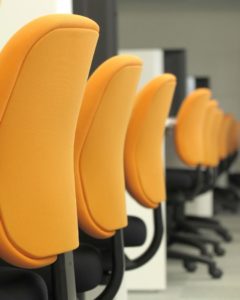After the “back in the office” honeymoon period is over we’ll probably go back to moaning about the temperature, the lack of parking and asking why The Best of Abba is playing on Spotify (again!). We’ll go back to asking whether we can improve the room booking system so that Procurement don’t have a monopoly on a meeting room just because it is located beside their work zone.
Will meetings, be any different from before? Will we keep the habit of waving goodbye to our colleagues at the end of the meeting as we seem to be doing right now? I doubt it. But, perhaps we will linger a little longer before rushing back to our desks.
There is likely to be a difference between internal and external meetings in the brave new world, with some of the changes already happening.
The chance to grab a colleague for 15 minutes to talk over a programme or to sketch over the top of plans will always be a vital component of how people work these days. Collaboration spaces need therefore to be designed accordingly and permissions and protocols shaped to support the activities and the spaces. While Teams has been a bit of a revelation for those of us not used to home-working, you can’t beat the “let’s grab a coffee, and bring that latest layout drawings with you” type of ad hoc meeting. In more and more workplaces, the concept of rapid exchange of information, the need to quickly write down ideas, have your colleagues critique them and add their own input, means that writable surfaces – walls, desks, even smartboards (?) – are now as important, if not more so, than the meeting room chairs, the table and the stylish credenza (that houses the corporate biscuits for safe keeping).
As one client said recently, “ideas don’t come at pre-planned times” so formal meeting rooms and room booking systems are potentially going to become less relevant in the future for many organisations. The growing shift from formal and bookable to informal and unbookable is as evident as the change from owned to shared spaces in the modern workplace.
OK, that’s ad hoc meetings between colleagues ‘sorted’.
What about those times when the client asks if you could come to their office and sit down with a few of the senior leadership team? The words “senior leadership team” do probably ‘encourage’ physical attendance; a whole swathe of lesser meetings can henceforth probably be done virtually. Now that we have seen how easy it is to use Teams or Zoom or Skype to chat to colleagues and clients and how easy it is to share information from our screens, are we going to propose that we reduce our carbon footprint by saying, actually let’s dispense with the need to have a real face-to-face and instead have a virtual visage-upon-visage (© Train Guy, 2020)?
Progress. The client has agreed to a virtual meeting. You’ve suggested video over audio, fine with them. At your desk? Hmm. Is a virtual video meeting any different from a telephone call in terms of disturbance? It depends on technology and whether you are using a headset or your laptop’s integrated microphone and speakers. If it’s the latter, then it would be fairer on your colleagues to find a more suitable spot away from your desk. Moving away from your desk also removes any potential for visual distraction, including from colleagues walking by and doing a quick check to see who is on the other end of the call.
Virtual collaboration needs different types of spaces. If a meeting room is free, then fine, go ahead and use it. (And we know from recent utilisation studies that meeting rooms continue to lie empty for a significant part of the week). To use a 4-or 6-person meeting room, or the boardroom, for what we would classify as individual work is not always possible though. Thus, we need to see more of these single person booths. Great for noise control, not great if you suffer from claustrophobia.
These types of spaces introduce an interesting dilemma – does the person being disturbed move away to find a quiet spot or does the person creating the disturbance vacate their desk? Chances are that if one person is causing a disturbance, even though we all react differently to noise, there is still a disturbance and not everyone can move. The same booth can respond to both occasions – the individual in search of P&Q or the banishment of the loudmouth. Workplace protocols and a modicum of self-awareness (often missed) will govern who moves.
So, it didn’t take a global pandemic to tell us that the days of a suite of meeting rooms are numbered, all it did was chalk off a few of those numbers.


